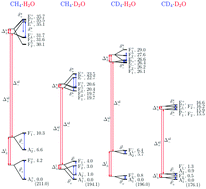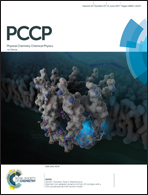Rovibrational quantum dynamical computations for deuterated isotopologues of the methane–water dimer†
Abstract
Rovibrational states of four dimers formed by the light and the heavy isotopologues of the methane and water molecules are computed using a potential energy surface taken from the literature. The general rovibrational energy-level pattern characteristic to all systems studied is analyzed employing two models of a dimer: the rigidly rotating complex and the coupled system of two rigidly rotating monomers. The rigid-rotor model highlights the presence of rovibrational sequences corresponding to formally negative rotational excitation energies, which is explained in terms of the coupled-rotors picture.



 Please wait while we load your content...
Please wait while we load your content...